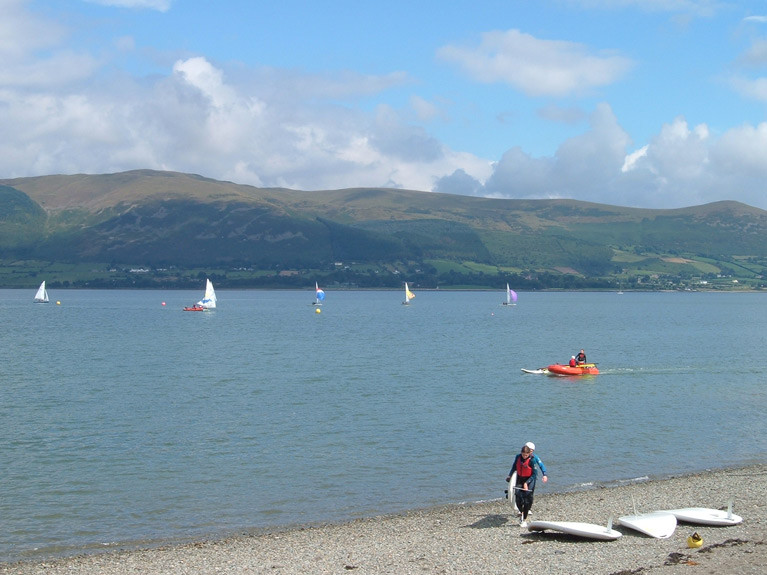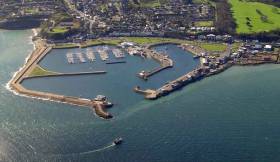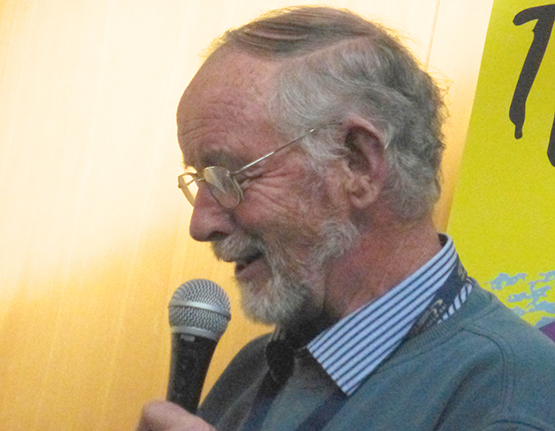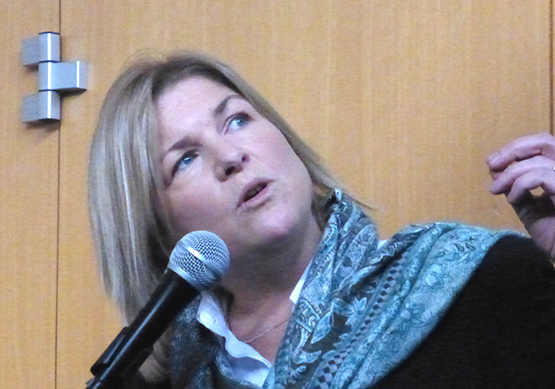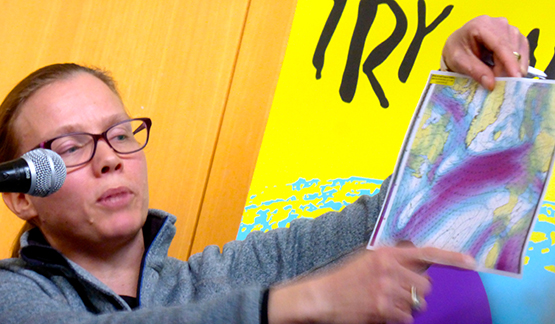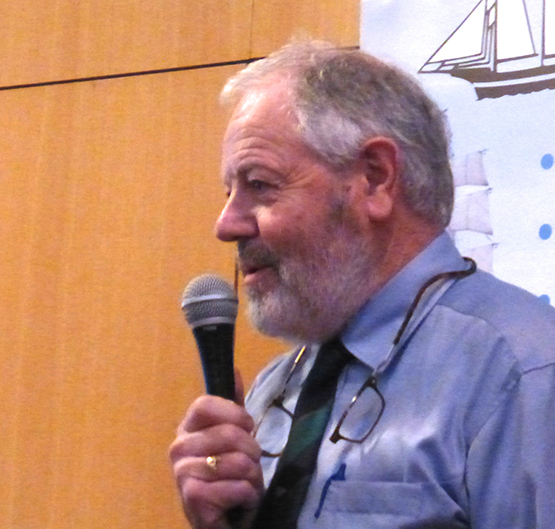Displaying items by tag: Cruising Association of Ireland
The Cruising Association of Ireland's Whistle Stop Cruise of the east coast of Ireland overnighted at Wicklow Harbour.
The association says the cruise has attracted a fleet of 23 boats since it commenced on Tuesday 22nd June.
The Cruising Association also intends to visit Arklow, Greystones, Skerries, Malahide and Dublin over the course of the six-day event.
Over 50 sailors are involved with 'enthusiastic cooperation from marinas and sailing clubs'.
On Saturday 27 June the cruise is headed for Dublin City. Dublin Port will open the Tom Clarke bridge and the fleet will berth at the long pontoon near the 3 Arena on the River Liffey.
Cruising Association of Ireland Cruise to Northern Waters
In a few days, a large fleet of 17 boats from the Cruising Association of Ireland will arrive in Belfast Lough. It's three years since they last cruised here in Northern Ireland. The contingent will include two boats from the North – David Meeke's Serenity from Royal Ulster and John Murphy from Carrickfergus SC in Enigma.
As Afloat reported previously, the plan is to depart Malahide by this Thursday (13th) heading north to gather in Carlingford Lough at the Marina the next day and then proceed to Belfast Lough for a muster in Belfast Harbour Marina on Monday 17th. After that, the fleet will be in Bangor Marina for 19th and 20th where Royal Ulster YC will welcome the crews for an evening meal. The cruise will finish with free sailing south.
Commodore Vincent Lundy is pleased that the CAI is going cruising. " It has been an incredibly difficult year for us all, but the bottom line is that we need to go cruising. Needless to say, we are bound to remain compliant with all restrictions imposed, and these same conditions will dictate the levels of social interaction for the safety of our membership. Indeed is our duty to do so. A special welcome is extended to new members and those with homeports in the Northern Region".
The Cruising Association of Ireland says there is a lot of interest being shown in their first event of the season which is a sail around the Kish Bank at the entrance to Dublin Bay in a Cruise-in-Company on 25th July.
A gathering of boats at the Kish lighthouse will arrive mainly from locations on the east coast of Ireland.
From the Kish, the members will sail to Dun Laoghaire Harbour. There, they will join the Royal Irish Yacht Club for their BBQ to which they have kindly invited the CAI. The meeting of boats at the Kish is planned for 14:00hrs to be followed by the RIYC BBQ starting at 16:00hrs. Some boats may layover in Dun Laoghaire while others will have time to sail home before dusk.
Summer cruise to Belfast
The CAI had planned a summer cruise to Scotland in June, but this has been replaced by a cruise to the loughs of Carlingford and Belfast. The itinerary will include three primary locations, namely, Malahide, Carlingford and Bangor where the catering and social arrangements have been prepared in advance. In between the primary locations, boats may free sail, visiting places like Ardglass, Portaferry, Belfast, Carrickfergus and more. As Afloat previously reported, the cruise will be from the 12th to 23rd August.
It is just over three years since the Cruising Association of Ireland fleet visited Belfast Lough. And now another trip north is planned for the middle week of August. The CAI has managed to keep active through the COVID 19 Lockdown with virtual meetings and online talks, during which time the membership has satisfyingly increased by 10%, including several new members from the North.
Commodore Vincent Lundy said “It has been an incredibly difficult year for us all but the bottom line is that we need to go cruising. Needless to say, we are bound to remain compliant with all restrictions imposed and these same conditions will dictate the levels of social interaction for the safety of our membership. Indeed is our duty to do so”.
This year the cruise-in-company is based around key locations where a greater number of boats may be accommodated within the safety of a marina able to berth reasonable numbers.
After a muster in Malahide on 12th August, the fleet will head north to Carlingford Lough, that spectacular fiord like stretch of water with the Mourne Mountains on the north and the Cooley Mountains to the south. Then on north to Belfast Harbour Marina, right in the centre of the city close to Titanic Belfast, followed by the option of moving on to the historic town of Carrickfergus with its Norman castle or heading east down the Lough to Bangor. From 21st August its free sailing home with the possibility of a visit to another fiord like sea inlet, the island-studded Strangford Lough.
The catering arrangements at each location is under continual review with respect to the current COVID guidelines
Cruising Association of Ireland’s Three Bridges Lift Raises €1,000 for Dun Laoghaire RNLI
The Cruising Association of Ireland’s popular “Three Bridges Lifted” Rally to Dublin Port in September was a festive occasion in a weekend of exceptionally good weather, and a large fleet celebrated the camaraderie of seafaring and boats and cruising until a late hour.
But while enjoying themselves, they didn’t forget the selfless dedication of those who voluntarily keep our seas safe, and an impromptu collection for the lifeboat service very quickly raised €1,000 which was duly presented to the RNLI Dun Laoghaire lifeboat crew by CAI Commodore Vincent Lundy and Honorary Treasurer Bryan Downey during a recent Lifeboat Exercise evening beside the harbour.
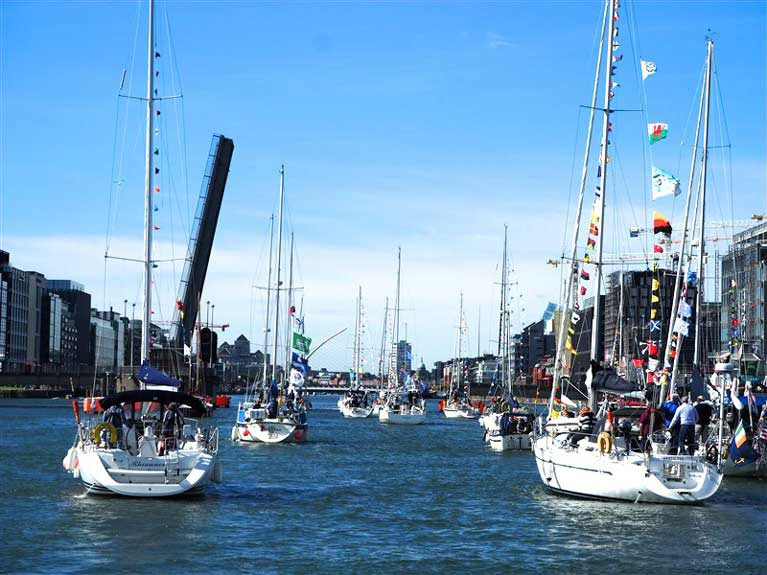 A perfect end to the cruising season – the Cruising Association of Ireland’s “Three Bridges Lifted” Rally in Dublin Port last month. Photo: Aidan Coughlan
A perfect end to the cruising season – the Cruising Association of Ireland’s “Three Bridges Lifted” Rally in Dublin Port last month. Photo: Aidan Coughlan
Liffey Bridges Lift For End-Of-Season Cruising Rally This Saturday
#Cruising - The Cruising Association of Ireland brings a successful 2018 to a close with their annual Three Bridges Rally in the River Liffey in Dublin city centre this Saturday 15 September.
Supported by Dublin Port and Dublin City Council, the event will see all three Liffey spans east of the Talbot Memorial Bridge — namely the Sean O’Casey, Samuel Beckett and East-Link — lift at 3pm on Saturday for the 30 or more yachts to sail upriver as far as the Custom House.
After a circuit of the Liffey, the boats will berth at the Dublin Port pontoon, near Point Village, which has been extended to 200 meters to accommodate the rally. The port will also host a Commodore’s reception with fine dining and entertainment that evening.
However, cruisers shouldn’t party too hard, as lines will slip early on Sunday at 11am when the East Link opens to let the passenger ship St Brigid into Dublin Bay.
This summer the CAI — a group of more than 120 cruising sailors who organise events and support each other’s adventures — conducted rallies to the Clyde in Scotland, Malahide and Greystones, and some yachts have spent a month or more cruising extensively. For more visit www.cruising.ie.
The Cruising Association of Ireland is already well into a busy season in 2017, but it moves up a gear this weekend with the AGM at Howth presided over by Commodore Clifford Brown tomorrow (Saturday) at 1800hrs, and based around a rally of East Coast members and their boats followed by a dinner, with CAI folk from other parts of Ireland travelling overland to the venue writes W M Nixon.
Last year the CAI AGM & Rally in the Spring was used to mark the opening of the new Greystones Sailing Club with GSC Commodore Dave Nixon as CAI’s Guest of Honour. This year in the more mature marina at Howth, the home club are celebrating the 30th Anniversary of their clubhouse – a winner of architectural awards when it was opened in 1987 – while the marina itself has been in action for nearly 35 years.
The CAI programme in 2017 is impressive, as they started with the Kish Muster in Dublin Bay on 8th April with the overnight at the hospitable National YC. This weekend of May 13th-14th, the focus swings to Howth, then on June 3rd to 5th a significant contingent will be at the Dublin Port festival, while they’re back to meet their old friends in Greystones on 10th to 11th June.
This year’s Cruise-in-Company is focused on Belfast Lough from July 3rd to 10th, then after a mid-season hiatus when many members expect to be doing individual cruises, they gather again on 12th August for an East Coast Rally at either Arklow or Carlingford, depending on the weather. Their East Coast season is rounded out by the traditional and popular Liffey 3 Bridges Cruise on 16th/17th September, when the opening bridges in the heart of Dublin are co-ordinated to allow the CAI fleet through for an convivial assembly which culminates in feasting aboard the Dublin Restaurant Ship Cill Airne.
 The popular Cruising Association of Ireland 3 Bridges Cruise in September sees the Liffey bridges co-ordinated for a shared opening time to allow the fleet through. Photo : W M Nixon
The popular Cruising Association of Ireland 3 Bridges Cruise in September sees the Liffey bridges co-ordinated for a shared opening time to allow the fleet through. Photo : W M Nixon
While Saturday night’s AGM and dinner at Howth has a certain business-to-be-done emphasis to it, around a dozen boat think it’s only right and proper to sail there, none more so than the renowned Charlie Kavanagh of Wicklow. His Sadler 34 Stravaiger was wintered in a berth in Kilmore Quay, and he was keen to sail to the Howth AGM. But with a period of cold nor’easters threatening, he grabbed a brief weather window on Sunday night by press-ganging shipmate and Wicklow SC Hon. Sec. Peter Shearer into an overnight passage, and they were rewarded with fair easterly winds for a dream sail to Wicklow, admittedly in decidedly crisp temperatures.
So now Stravaiger is conveniently poised to sail north to Howth either this evening or tomorrow morning, and with his new season properly under way, Charlie Kavanagh’s plans for Stravaiger in 2017 include a leisurely Round Ireland cruise.
Sailing and cruising history of all sorts has been made at Greystones over the weekend reports W M Nixon, with the new harbourside clubhouse opening on Friday, and then on Saturday the new multi-function facility hosted its first event, the 2016 Annual General Meeting and start-of-season Rally of the Cruising Association of Ireland.

The new Greystones clubhouse had been open for less than a day when 79 hungry and thirsty Cruising Association members put the catering facilities to the test on Saturday night with a three course dinner. Photo: Aidan Coughlan

Commodore Nixon (GSC) and Commodore Brown (CAI) in a convivial burgee exchange. Photo: Aidan Coughlan
Evidently they’re not superstitious down North Wicklow way, as the clubhouse came into action on Friday 13th, and thirteen boats headed from various ports to take part in the CAI Rally. The AGM was put through with exemplary briskness, with Commodore Clifford Brown continuing in the top office of the CAI. Burgees were exchanged with Greystones Sailing Club Commodore David Nixon, and the still-barely-out-of-the-wrappers catering facilities were put to the test with 79 hungry and thirsty cruising and sailing enthusiasts tucking into a three course dinner as the afterglow of a perfect sunset lingered over the Wicklow hills.
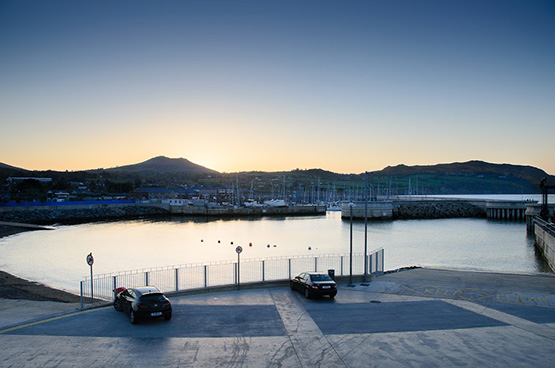
The afterglow of a perfect sunset over Greystones Marina as seen from the new clubhouse on Saturday night. Photo: Aidan Coughlan
ISA Cruising Conference Was On Target For Topics And Turnout
Last Saturday’s Irish Sailing Association National Cruising Conference, sponsored by Union Chandlery with full organisational support from the Cruising Association of Ireland and the enthusiastic hospitality of Howth Yacht Club, was able to put through a very complete day-long programme which covered an extraordinary variety of topics. Each area of interest was examined in detail by a leading expert – in some cases the CEO of the national agency involved – and by the end the attendees, who came from all over the country, were verging on information overload. Yet everyone finished the day well satisfied, and certainly agreed on one thing – it will be quite something to match the quality of 2016’s Cruising Conference when the next one comes round in 2018. W M Nixon was there, and though he tells us “his head was melted” with the sheer volume of the range of issues discussed and explained, he’ll do his best to let us know what happened.
It went on for seven hours and more, and ranged from the extremities of dealing with calving glaciers in Greenland at one end, to the niceties of lone male watch-keepers dealing safely and efficiently with the calls of nature in mid ocean at the other. And since you ask, there were two distinct camps for dealing with Problem B – those who favour a simple bottle, narrow enough to be stowed in a convenient winch handle holder, and those who think a yoghurt tub with its cover kept usable is your only man, as some folk need a bit of space to perform.
As for the sheer length of the programme, as a group of friends and shipmates attending together we agreed it should have been an hour shorter. But then we couldn’t think of one single item on the agenda that we would have happily discarded. So for 2018 (or next year, if the current plan to make it biennial is reckoned to be wimpishly unambitious), Paddy McGlade the ISA Board Member for Cruising, and Clifford Brown, Commodore of the Cruising Association of Ireland, will have to agree to the same densely-filled programme, and it’s beholden on the participants and the audience to be up for the challenge.
For the fact is, when you get an attendance of this calibre, you need to provide the full coverage in the programe. And if you’re providing the full service in the form of a very comprehensive conference, then you deserve the attendance of all the keenest cruising folk – or would-be cruising folk – in the entire country. And with a comprehensive turnout of 104 enthusiasts where all nvolved on either side of the programe are incuded - when they’d tried initially to keep the numbers manageably at 80 - the dynamic interaction between performers and audience was magic, and ISA President David Lovegrove was properly impressed.
ISA Cruising Convener Gail MacAllister put together a cracking programme, nicely balancing the serious issues which might have had a certain bureaucratic overtone with more overtly entertaining stuff which hit the button either by scaring us stiff, or else making us savour the pure quiet delight of a proper cruise going well with a contented crew on board.
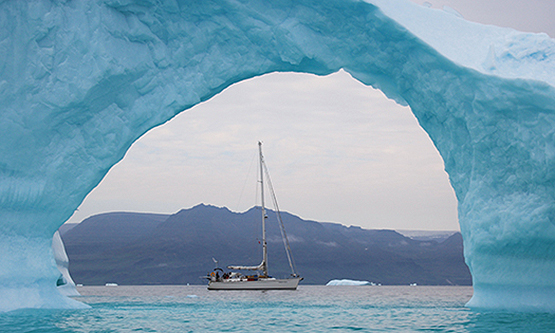
Eddie Nicholson’s Najad 440 Mollihawk’s Shadow in the frame in Greenland. The outline he gave of the pre-planning and execution with shipmates Mike Hodder and Dermot O’Morchoe of this exemplary cruise from Newfoundland eventually home to Ireland was to set the tone for the ISA Cruising Conference.
The tone was set from the start with the all-singing all-dancing account of Eddie Nicholson of Kinsale’s cruise to West Greenland and then on to Ireland from Labrador with the Najad 440 Mollihawk’s Shadow. This was much more than the narrative of an ambitious cruise. Combined with his two leading shipmates Mike Hodder and Dermot O’Morchoe, Eddie makes up a threesome of complementary talents, and their thoughtful account of what goes into planning, preparing and making such a cruise the outstanding success it clearly became was shown in the concluding informative account of what they achieved, once they’d made the effort to put everything in place.
This was obviously at the more advanced end of cruising, so as a balance we next heard from ISA Board Member Pierce Purcell of Galway, who has been on a personal crusade to fire up the interest of all recreational boat owners around Galway Bay. He runs a chandlery at Clarinbridge, and the sheer variety of people from all parts who were coming through his door in quest of maritime items large and small made him realise that his shop was a maritime focal point for the entire Galway Bay area.
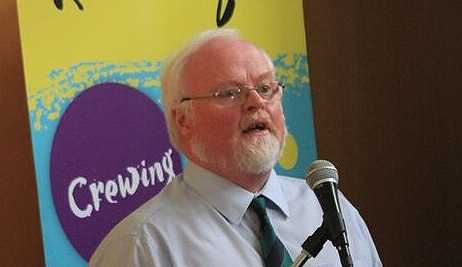
Pierce Purcell of the ISA Board outlining his innovative technique for building up a communications network of recreational boating enthusiasts around Galway Bay
So every time he sold something, he simply asked the customer if he could have their email address to keep them informed of anything that might be in the offing for boaters large and small around Galway Bay. As a result, in the last decent summer, which we had a couple of years ago if you remember, he managed to assemble a fleet of fifty-plus boats for a Bank Holiday weekend muster at Kilronan in the Aran Islands. And as a direct result of that, the WIORA Championship 2017 is going to be staged at the same venue, which will be a remarkable “first”.
The extraordinary opportunities which cruising offers for observing maritime wildlife were then outlined by Simon Berrow of the Irish Whale & Dolphin Group, and his continuing enthusiasm is at such a level that just about everyone present will be on some sort of whale watch in the season ahead.
Dr Berrow is based in Kilrush, and there’s something about the West of Ireland which sets the sailing heart afire, for we then had Daria Blackwell of Clew Bay telling us how women can get much greater enjoyment from sailing if they take steps to learn how to do it themselves, indeed the best thing is to do it well because you want to, not because some mere male needs help.

Daria Blackwell delivering the message about women adopting a more proactive role in sailing through having the most positive attitude to learning and practice. Photo: Alex Blackwell

Molly Childers on the wheel aboard Asgard in 1912. She was a much more competent helm than her husband Erskine, and it was she who made such a masterful job of steering the engine-less Asgard into Howth with a strong following wind during the gun-running episode in 1914.
This made it doubly appropriate that the conference was taking place in Howth Yacht Club, for of course in July 1914 Howth witnessed one of the finest examples of skilled helming by a woman when Molly Childers steered the engineless Asgard safely into harbour and alongside in the allotted tight berth for the Irish Volunteers Gun Running, despite a Force 5 to 6 northwest wind from dead astern.
Daria used to be the boss of a 400–employee advertising agency in New York, so when she got the sailing bug she went at it with total dedication. It made for a fascinating presentation as she outlined the different ways that men and women approach something like learning to helm a boat in confined situations.
Apparently we men rely on intuitive learning – we hope to pick it up simply by doing it. And if it involves fixing a piece of equipment, we’d rather have a blind go at it instead of RTFM. But women, according to Daria, want to learn properly - they want to practice, they’re keen to take instruction if it’s properly done, and they want to continue to get it right without feeling nervous about doing it again. Practice and self-reliance – that’s what women bring to enjoyment of sailing. And yes, they do read the manual.
Norman Kean of Courtmacsherry, Honorary Editor of the Irish Cruising Club Sailing Directions, is a typical Royal Institute of Navigation person in that, while he’s ace with all the latest equipment, he has a great love and respect for all the paraphernalia of his art, and he adores charts. But he doesn’t suffer from any illusions about the fact that some of our best-loved charts are based on data so old that a re-survey would show that some narrow channels are not quite where they’d be indicated on an electronic chart, where the original info has had to come from a paper chart.
So in an intriguing presentation he showed us some electronic anomalies of which the most vivid was the slight but crucial mis-placing of the Joyce Sound inside Slyne Head in County Galway, and then he went on to show us how much attention to detail was needed for himself and Geraldine to take their Warrior 40 Coire Uisge into Blind Harbour on Waterford’s Copper Coast.

Coffee break. Navigation guru Norman Kean (facing left) talks charts with fellow enthusiasts. Photo: W M Nixon
The organisers maintained a ferocious pace, for before we were allowed to take time for lunch, there was a break-out session with instant groups of eight or so each being formed to discuss various topics on which, at conferences end, one lucky nominee from each group had to produce a considered report. My recollection is that the problem with lobster pot marker lines loomed large, and in our group we’d the good fortune to have Paddy Judge who told us how he’d cleared a pot line which had got between his skeg and rudder – thereby disabling his steering. He’d managed to get to the lobster line by use of a short length of chain with a line at either end, the chain let over the bow with the line to each side, and then worked aft well under water until it could be used to raise the pot line, which was running vertically downwards from the rudder.
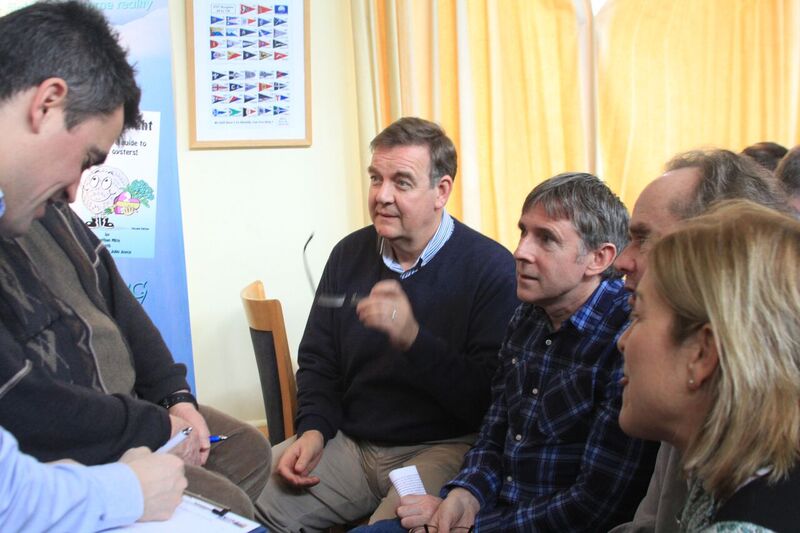
Taking a day off from the general election, RTE News Presenter Brian Dobson was one of 104 cruising and offshore sailors who took part in the ISA Conference. Photo: Alex Blackwell
The whole business of virtually unmarked pot lines all round the Irish coast is becoming such a problem that we’ll probably have a blog completely devoted to it one day. But the good news from Saturday is that the energetic Gary Davis of the HYC Cruising Group has been so determined in his lobbying of politicians and government departments regarding the menace of poorly-marked pot lines that it’s now on the official agenda, which is quite a step forward from the previous apparent indifference.
The conclusions from the break-out groups were to come at the end of the Conference, and provided food for thought with Gary Davis’s news about the new political awareness getting much approval, while there was something of a round of applause for Paddy Judge’s ingenious solution – I omitted to mention he was single-handed at the time of the incident.
The afternoon went promptly into further presentations, with CAI Commodore Clifford Brown putting out the welcome mat for newcomers in a big way. If you wanted to find a catchphrase for the entire conference, “infectious enthusiasm” would be right on target, and Commodore Brown’s exposition, cheerfully outlining the multiple choice in sailing and cruising experience which the CAI members are happy to offer to anyone even slightly interested, was encouraging to behold.

“You’re all welcome, very welcome….” Cruising Association of Ireland Commodore Clifford Brown outlines what his organisation has to offer to experienced sailors and absolute beginners alike. Photo: Alex Blackwell
A star performer. Pat Murphy’s guidance on welcoming and managing new crew drew on his unrivalled experience gained in a nine year round the world cruise. Photo: W M Nixon
However, “inspiring” is the only way to describe the next speaker. Pat Murphy has his top place for ever inscribed in Irish sailing history thanks to his fabulous nine year voyage round the world with his late wife and soulmate Olivia on their fine 40ft cutter Aldebaran. They learned much from it, and as they had guest crews aboard at regular intervals, they learned a great deal more about how to manage and welcome new crew. Pat was hugely generous in imparting nuggets of sound advice and insights culled from an exceptional cruise, and it all combined into a solid body of purest wisdom.
But then came the really serious bit. Chris Reynolds, Director of the Irish Coastguard, took us on an informative tour of his expanding organization, and guided us on the paths to sea safety and the correct course of action in an emergency. These topics had of course come up during the group discussions, where the more senior cruising folk inclined to the view that the joy of cruising is to be found in self-reliance, and if a problem arises you should take pride and satisfaction in solving it yourself, however much the potential or actual risk.

The friendly face of the rescue services – Chris Reynolds is Director of the Irish Coastguard. Photo: Alex Blackwell
But that was appropriate a long time ago, before a proper matrix of rescue and support serves was in place. You just had to be almost totally self-reliant in the old days. Yet nowadays, according to Chris Reynolds, it’s irresponsible to persist in that attitude. His message was simple. If you think you might be getting into trouble, then it’s time to alert the rescue service. For if you know you’re getting into trouble, then it may already be too late to call the rescue services.
This caused some heart-searching among traditionalists, but we hadn’t time to dwell on it, as the next speaker was the force of nature otherwise known as Vera Quinlan of INFOMAR in the Marine Institute in Galway. INFOMAR is the INtegrated Mapping FOr the sustainable development of Ireland’s MARine resource, and Vera Quinlan – a noted ocean cruising sailor in her own right – has been at the heart of it for eight years.
A Force of Nature – Vera Quinlan of INFOMAR. Photo: W M Nixon
If anyone’s interest in the future of the sea had been flagging at this stage, Vera’s enthusiasm soon fired it up again. It’s a whole new world out there, on and under the ocean, when you see it through INFOMAR eyes. And Vera’s vision for Ireland’s maritime future was just the tonic for people who sometimes tend too much to see it as no more than a playground.
The fact that she both works with it, and shows its manifold possibilities for all sorts of sustainable uses, and then goes on to sail across it for pleasure every summer - that was thought-provoking in the extreme. And so too was the concluding item, which had John Leahy, former Commodore of the CAI and a retired airline captain, and Willemien Phelan of Met Eireann in an informal competition to see who had best predicted the weather which would obtain on the day of the conference, using different forecast models in different time spans.
Both had got it pretty much spot on in their predictions a week in advance, but then we were in a spell of routine winter weather with the Great Purple Snake of Atlantis, otherwise known as the Jetstream in high speed mode, weaving across the country with one unpleasantness fairly regularly after another.
“The Great Purple Snake of Atlantis” – Willemien Phelan of Met Eireann with a particularly lurid recent swirling of the Jetstream right across Ireland. Photo: W M Nixon
Since last weekend, as you’ll have noticed the Jetstream took off for two or three days to the sunny south, which consequently wasn’t sunny any more, but Ireland certainly was. However, the Great Snake of Atlantis is due back over us today, but at least you’ll know now why the weather goes to pot when it does.
All this was only part of the wide-ranging presentation given by John and Willemien which showed just how far weather prediction has come on in recent years. The magic Ten Day Forecast may still be out of reach beyond a certain level of accuracy, but they’re closing in on the one week forecast very well indeed these days.
All of which poses a quandary for anyone organising sailing events or planning cruises. For if all the forecasts give the same message, that in a week’s time the weather is going to be plain awful with too much wind for most racing, then you’re faced with the decision of calling it off with plenty of time to spare to enable people to plan other things, or else you just stick to the programme and hope the forecast has been excessively pessimistic.
And on top of that, if several days in advance you do cancel an event whose date was set way back in the winter, when on earth are you going to slot it in later in our current programme, which is jam-packed from one weekend to the next?
But that was only one of many thoughts flying around the Conference last Saturday, and most of them were much more cheerful. The reality is cruising folk just like to get together and talk about boats and cruising until the cows come home, and if a Cruising Conference is organized with a stellar line-up of speakers, it gives it all a sense of extra purpose.
Paddy McGlade, ISA Board Member for Cruising, reviews a successful conference. Photo: W M Nixon
Long after a deservedly happy Paddy McGlade brought this part of the gathering to a conclusion after the draw for the offshore sailing suit donated by Union Chandlery had resulted in a popular win for Terry McCoy of Skerries, people were still contentedly shooting the breeze in the friendly atmosphere of the clubhouse. And the really keen ones were lining themselves up for that night’s annual dinner of the CAI. Cruising people are like that – they’re in for the long haul.

It’s all for Terry! Terry McCoy with Gail MacAllister after the Skerries sailor had won the draw for the sailing suit. Photo: Alex Blackwell
Irish Cruising Comes Centre Stage In Howth Yacht Club
With last night’s Irish Cruising Club Annual General Meeting & Prize-Giving hosted at Howth Yacht Club, and this morning’s day-long ISA Cruising Conference at the same venue, centre stage has been taken by the silent majority – the large but distinctly reticent segment of the sailing population which emphatically does not have racing as its primary interest afloat. W M Nixon takes us on a guided tour.
The great Leif Eriksson would approve of some of the more adventurous members of the Irish Cruising Club. They seem to be obsessed with sailing to Greenland and cruising along its coast. And it was the doughty Viking’s father Erik Thorvaldsson (aka Erik the Red) who first told his fellow Icelanders that he’d given the name of Greenland to the enormous island he’d discovered far to the west of Iceland. He did so because he claimed much of it was so lush and fertile, with huge potential for rural and coastal development, that no other name would do.
Leif then followed in the family tradition of going completely over the top in naming newly-discovered real estate. He went even further west and discovered a foggy cold part of the American mainland which he promptly named Vinland, as he claimed the area was just one potential classic wine chateau after another, and hadn’t he brought back the vines to prove it?
In time, Erik’s enthusiasm for Greenland was seen as an early property scam. For no sooner had the Icelanders established a little settlement there around 1000 AD than a period of Arctic cooling began to set in, and by the mid-1300s there’d been a serious deterioration of the climate. What had been a Scandinavian population of maybe five thousands at its peak faded away, and gradually the Inuit people – originally from the American mainland – moved south from their first beachheads established to the northwest around 1200 AD. They proved more successful at adapting to what had become a Little Ice Age, while no Vikings were left.
Now we’re in the era of global warming, and there’s no doubt that Greenland is more accessible. But for those of us who think that cruising should be a matter of making yourself as comfortable as possible while your boats sails briskly across the sea in a temperate climate or perhaps even warmer for preference, the notion of devoting a summer to sailing to Greenland and taking on the challenge of its rugged iron coast, with ice everywhere, still takes a bit of getting used to.
Yet in recent years the Irish boats seem to have been tripping over each other up there. And for some true aficionados, the lure of the icy regions was in place long before the effects of global warming were visibly making it more accessible.
Peter Killen of Malahide, Commodore of the Irish Cruising Club, is a flag officer who leads by example. It was all of twenty years ago that he was first in Greenland with his Sigma 36 Black Pepper, and truly there was a lot of ice about. The weather was also dreadful, while Ireland was enjoying the best summer in years.

Peter Killen’s Sigma 36 Black Pepper in local ice at the quay inside Cape Farewell in Greenland, August 1995

ICC Commodore Peter Killen’s current boat is Pure Magic, an Amel Super Maramu seen here providing the backdrop for a fine penguin in Antarctica, December 2004.
More recently, he and his crew of longterm shipmates have been covering thousands of sea miles in the Amel Super Maramu 54 Pure Magic, among other ventures having a look at lots more ice down Antarctic way to see how it compares with the Arctic. With all their wanderings, by the end of the 2014 season Pure Magic was laid up for the winter in eastern Canada in Nova Scotia. So of course in order to get back to Ireland through 2015, the only way was with a long diversion up the west coast of Greenland. And the weather was grand, while Ireland definitely wasn’t enjoying the best summer in years.
The Pure Magic team certainly believe in enjoying their cruising, however rugged the terrain. If the Greenland Tourist Board are looking for a marketing manager, they could do no better than sign up the skipper of Pure Magic for the job. His entertaining log about cruising the region – featured in the usual impressive ICC Annual edited for the fourth time by Ed Wheeler – makes West Greenland seem a fun place with heaps of hospitality and friendly folk from one end to the other.

If ice is your thing, then this is the place to be – Peter Killen’s Pure Magic off the west Greenland coast, summer 2015.
But then Peter Killen is not as other men. I don’t mean he is some sort of alien being from the planet Zog. Or at least he isn’t so far as I know. But the fact is, he just doesn’t seem to feel the cold. I sailed with him on a raw Autumn day some years ago, and while the rest of us were piling on the layers, our skipper was as happy as Larry in a short-sleeved shirt.
I’d been thinking my memory had exaggerated this immunity to cold. But there sure enough in the latest ICC Annual is a photo of the crew of Pure Magic enjoying a visit to the little Katersugaasivik Museum in Nuuk, and the bould skipper is in what could well be the same skimpy outfit he was wearing when we sailed together all those years ago. As for the rest of the group, only tough nut Hugh Barry isn’t wearing a jacket of some sort – even Aqqala the Museum curator is wearing one.
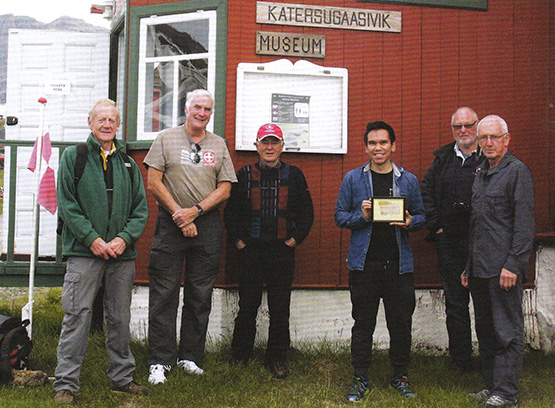
Some folk feel the cold more than others – Pure Magic’s crew absorbing local culture in Greenland are (left to right) Mike Alexander, Peter Killen, Hugh Barry, Aqqalu the museum curator, Robert Barker, and Joe Phelan
Having a skipper with this immunity to cold proved to be a Godsend before they left Greenland waters, when Pure Magic picked up a fishing net in her prop while motoring in a calm. Peter Killen has carried a wetsuit for emergencies for years, and finally it was used. He hauled it on, plunged in with breathing gear in action, and had the foul-up cleared in twenty minutes. Other skipper and Commodores please note……
The adjudicator for the 2015 logs was Hilary Keatinge, who has one of those choice-of-gender names which might confuse, so it’s good news to reveal that after 85 years, the ICC has had its first woman adjudicator. No better one for the job, man or woman. Before marrying the late Bill Keatinge, she was Hilary Roche, daughter of Terry Roche of Dun Laoghaire who cruised the entire coastline of Europe in a twenty year odyssey of successive summers, and his daughter has proven herself a formidable cruising person, a noted narrator of cruising experiences, and a successful writer of cruising guides and histories.
Nevertheless even she admitted last night that once all the material has arrived on the adjudicator’s screen, she finally appreciated the enormity of the task at hand, for the Irish Cruising Club just seems to go from strength to strength. Yet although it’s a club which limits itself to 550 members as anything beyond that would result in administrative overload and the lowering of standards, it ensures that the experience of its members benefit the entire sailing community through its regularly up-dated sailing directions for the entire coast of Ireland. And there’s overlap with the wider membership of the Cruising Association of Ireland, which will add extra talent to the expert lineup providing a host of information and guidance at today’s ISA Cruising Conference.
But that’s this morning’s work. Meanwhile last night’s dispensation of the silverware – some of which dates back to 1931 – revealed an extraordinarily active membership. And while they did have those hardy souls who ventured into icy regions, there were many others who went to places where the only ice within thousands of miles was in the nearest fridge, and instead of bare rocky mountains they cruised lush green coasts.
Nevertheless the ice men have it in terms of some of the top awards, as Hilary Keatinge has given the Atlantic Trophy for the best cruise with a passage of more than a thousand miles to the 4194 mile cruise of Peter Killen’s Pure Magic from Halifax to Nova Scotia to Howth, with those many diversions on the way, while the Strangford Cup for an alternative best cruise goes to Paddy Barry, who set forth from Poolbeg in the heart of Dublin Port, and by the time he’d returned he’d completed his “North Atlantic Crescent”, first to the Faeroes, then Iceland to port, then across the Denmark Strait to southeast Greenland for detailed cruising and mountaineering, then eventually towards Ireland but leaving Iceland to port, so they circumnavigated it in the midst of greater enterprises.
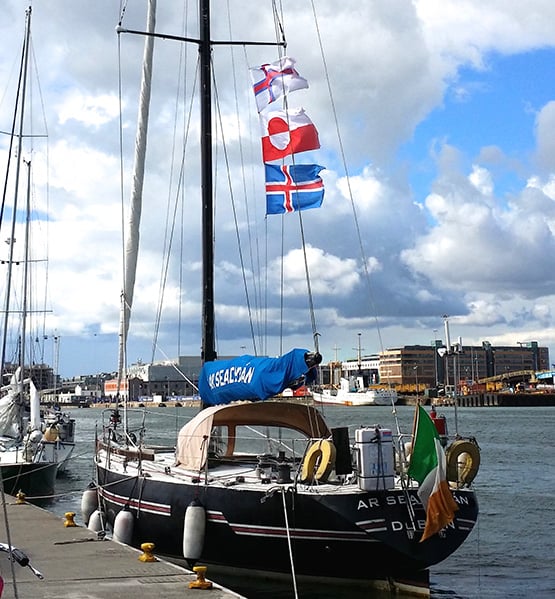
You collect very few courtesy ensigns in the frozen north. Back at Poolbeg in Dublin after her “North Atlantic Crescent” round Iceland and on to Greenland, Paddy Barry’s Ar Seachran sports the flags of the Faroes, Iceland and Greenland. Ar Seachran is a 1979 alloy-built Frers 45. Photo: Tony Brown
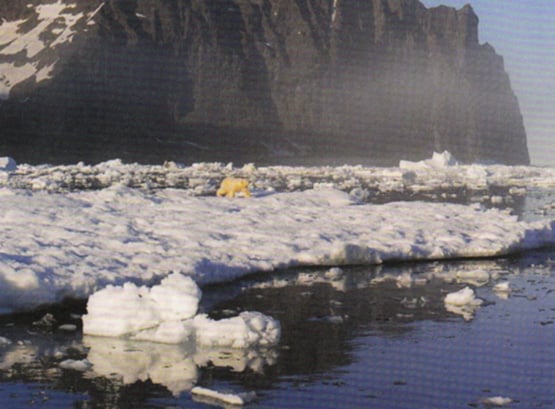
“Definitely the Arctic”. A polar bear spotted from Ar Seachran. Photo: Ronan O Caoimh
Paddy Barry started his epic ocean voyaging many years ago with the Galway Hooker St Patrick, but his cruising boat these days is very different, a classic Frers 45 offshore racer of 1979 vintage. Probably the last thing the Frers team were thinking when they turned out a whole range of these gorgeous performance boats thirty-five years ago was that their aluminium hulls would prove ideal for getting quickly to icy regions, and then coping with sea ice of all shapes and ices once they got there. But not only does Paddy Barry’s Ar Seacrhran do it with aplomb, so too does Jamie Young’s slightly larger sister, the Frers 49 Killary Flyer (ex Hesperia ex Noryema XI) from Connacht, whose later adventures in West Greenland featured recently in a TG4 documentary.
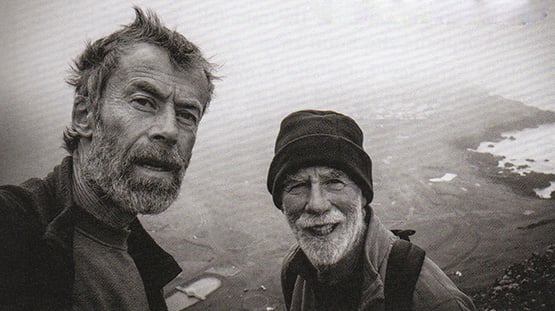
“A grand soft day in Iceland”. Harry Connolly and Paddy Barry setting out to take on mountains in Iceland during their award-winning cruise to Greenland. Photo: Harry Connolly
Pure Magic and Ar Seachran are hefty big boats, but the other ICC voyager rewarded last night by Hilary Keatinge for getting to Arctic waters did his cruise in the Lady Kate, a boat so ordinary you’d scarcely notice her were it not for the fact that she’s kept in exceptionally good trim.
Drive along in summer past the inner harbour at Dungarvan in West Waterford at low water, and you’ll inevitably be distracted by the number of locally-based bilge-keelers sitting serenely upright (more or less) on that famous Dungarvan mud. There amongst them might be the Moody 31 Lady Kate, for Dungarvan is her home port.
But she was away for quite a while last year, as Donal Walsh took her on an extraordinary cruise to the Arctic, going west of the British mainland then on via Orkney and Shetland to Norway whose coast goes on for ever until you reach the Artic Circle where the doughty Donal had a swim, as one does, and looked at a glacier or too, and then sailed home but this this time leaving the British mainland to starboard. A fabulous 3,500 mile eleven week cruise, he very deservedly was awarded the Fingal Cup for a venture the adjudicator reckons to be extra special – as she puts it, “you feel you’re part of the crew, though I don’t think I’d have done the Arctic Circle swim.”
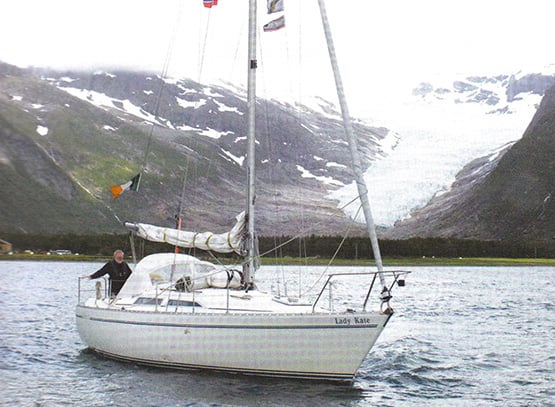
A long way from Dungarvan. Lady Kate with Donal Walsh off the Svartsen Glacier in northern Norway
Indeed, in taking an overview of the placings of the awards, you can reasonable conclude that the adjudicator reckons any civilized person can have enough of ice cruising, as she gives the ICC’s premier trophy, the Faulkner Cup, to a classic Atlantic triangle cruise to the Azores made from Dun Laoghaire by Alan Rountree with his van de Sadt-designed Legend 34 Tallulah, a boat of 1987 vintage which he completed himself (to a very high standard) from a hull made in Dublin by BJ Marine.
Tallulah looks as immaculate as ever, as we all saw at the Cruising Association of Ireland rally in Dublin’s River Liffey in September. And this is something of a special year for Alan Rountree, as completely independently of the Faulkner Cup award, the East Coast ICC members awarded their own area trophy, the Donegan Cup for longterm achievement, to Tallulah’s skipper. As one of those involved in the decision put it, basically he got the Donegan Trophy “for being Alan Rountree – what more can be said?”
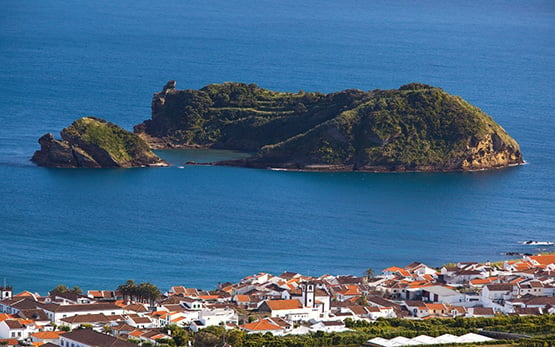
The essence of the Azores. Red roofs maybe, but not an iceberg in sight, and the green is even greener than Ireland. Alan Rountree’s succesful return cruise to the Azores has been awarded the ICC’s premier trophy, the Faulkner Cup.

Tallulah at the CAI Rally in the Liffey last Setpember. She looks as good today as when Alan Rountree completed her from a bare hull nearly thirty years ago. Photo: W M Nixon
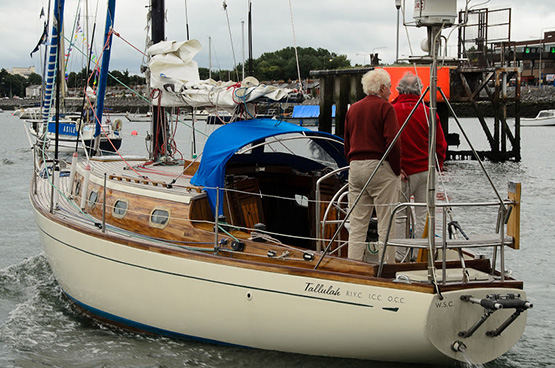
A boat to get you there – and back again. Tallulah takes her departure from the CAI Rally in Dublin. Photo: Aidan Coughlan
Well, it can be said that his Azores cruise was quietly courageous, for although the weather was fine in the islands, the nearer he got to Ireland the more unsettled it became, and he sailed with the recollection of Tallulah being rolled through 360 degrees as she crossed the Continental Shelf in a storm in 1991. But he simply plodded on through calm and storm, the job was done, and Tallulah is the latest recipient of a trophy which embodies the history of modern Irish cruising.
There were many other awards distributed last night, and for those who think that the ICC is all about enormous expensively-equipped boats, let it be recorded that the Marie Trophy for a best cruise in a boat under 30ft long went to Conor O’Byrne of Galway who sailed to the Hebrides with his Sadler 26 Calico Jack, while the Fortnight Cup was taken by a 32-footer, Harry Whelehan’s Jeanneau Sun Odyssey 32 for a fascinating cruise in detail round the Irish Sea, an area in which, the further east you get to coastlines known to very few Irish cruising men, then the bigger the tides become with very demanding challenges in the pilotage stales.
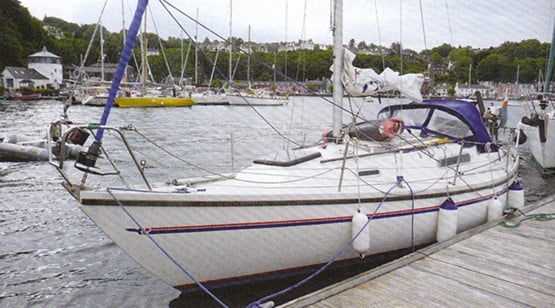
The smallest boat to be awarded a trophy at last night's Irish Cruising Club prize-giving was Conor O’Byrne’s Sadler 26 Calico Jack, seen here in Tobermory during her cruise from Connacht to the Hebrides
As for “expensively equipped”, the Rockabill Trophy for seamanship went to Paul Cooper, former Commodore of Clontarf Yacht & Boat Club and an ICC member for 32 years, who solved a series of very threatening problems with guts and ingenuity aboard someone else’s Spray replica during a 1500 mile voyage in the Caribbean, with very major problems being skillfully solved, as the judge observed, “without a cross word being spoken”.
Not surprisingly in view of the weather Ireland experienced for much of the season, there were no contenders for the Round Ireland cruise trophy, though I suppose you could argue that the return of Pure Magic meant the completion of a round Ireland venture, even if in this case the Emerald Isle becomes no more than a mark of the course.
In fact, with the unsettled weather conditions of recent summers in Ireland , there’s now quite a substantial group of ICC boats based out in Galicia in northwest Spain, where the mood of the coast and the weather “is like Ireland only better”. The ICC Annual gives us a glimpse of the activities of these exiles, and one of the most interesting photos in it is provided by Peter Haden of Ballyvaughan in County Clare, whose 36ft Westerly Seahawk Papageno has been based among the Galician rias for many years now.
Down there, the Irish cruising colony can even do a spot of racing provided it’s against interesting local tradtional boats, and Peter’s photo is of Dermod Lovett of Cork going flat out in his classic Salar 40 Lonehort against one of the local Dorna Xeiteras, which we’re told is the Galician equivalent of a Galway Bay gleoiteog. Whatever, neither boat in the photo is giving an inch.
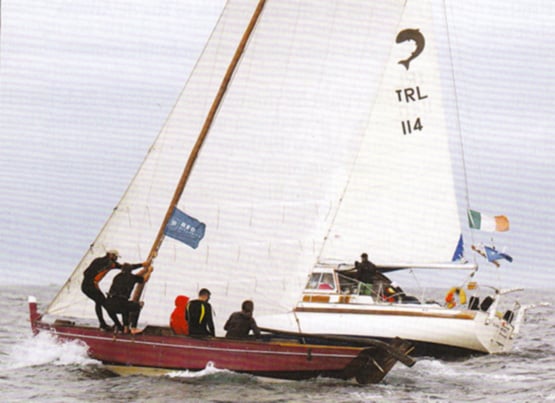
So who never races? Dermod Lovett ICC in competition with his Salar 40 Lonehort against a local traditional Dorna Xeiteira among the rias of northwest Spain. Photo: Peter Haden
Hilary Keatinge’s adjudication is a delight to read in itself, and last night after just about every sailing centre in Ireland was honoured with an ICC award for one of its locally-based members, naturally the crews leapt to the mainbrace and great was the splicing thereof.
But it’s back to porridge this morning in HYC and the serious work of the ISA Cruising Conference, where the range of topics is clearly of great interest, for the Conference was booked out within a very short time of being highlighted on the Afloat.ie website.
It’s during it that we’ll hear more about that intriguing little anchorage which provides our header photo, for although it could well be somewhere on the Algarve in Portugal, or even in the Ionian islands in Greece were it not for the evidence of tide, it is in fact on the Copper Coast of south Waterford, between Dungarvan and Dunmore East, and it’s known as Blind Harbour.
It’s a charming place if you’ve very settled weather, but it’s so small that you’d probably need to moor bow and stern if you were thinking to overnight, but that’s not really recommended anyway. Norman Kean, Editor of the Irish Cruising Club Sailing Directions, had heard about this intriguing little spot from Donal Walsh of Dungarvan (he who has just been awarded the Fingal Cup), and being Norman Kean, he and Geraldine just had to go and experience it for themselves. But it has taken three attempts to have the right conditions as they were sailing by, and it happened in 2015 in a very brief period of settled weather as they headed past in their recently-acquired Warrior 40 Coire Uisge, which has become the new flagship of the ICC’s informal survey flotilla.

The secret cove is to be found on Waterford’s Copper Coast, midway between Dungarvan and Dunmore East. Courtesy ICC
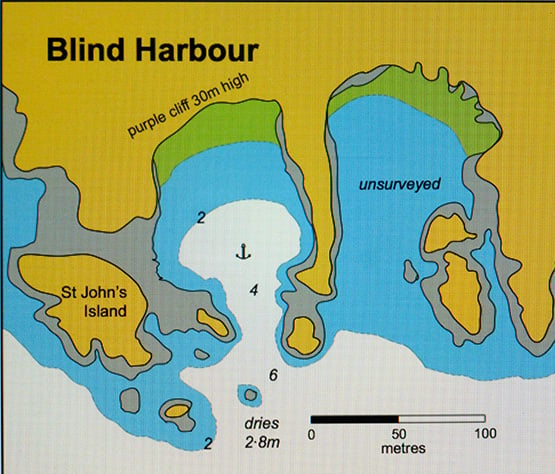
The newly-surveyed Blind Harbour on the Waterford coast as it appears in the latest edition of the ICC’s South & West Coasts Sailing Directions published this month. Courtesy ICC.
They found they’d to eye-ball their way in to this particular Blind Harbour (there are others so-named around the Irish coast) using the echo sounder, as any reliance on electronic chart assistance would have had them on the nearest part of County Waterford, albeit by only a matter of feet. With a similar exercise a couple of years ago, they found that the same thing was the case at the Joyce Sound Pass inside Slyne head in Connemara – rely in the chart plotter, and you’re making the pilotage into “impactive navigation”.
The message is that some parts of charts are still relying on surveys from a very long time ago, and locations of hyper-narrow channels may be a few metres away from where they actually are. On the other hand, electronic anomalies may arise. Whatever the reason, I know that a couple of years ago, in testing the ship’s gallant little chart plotter we headed for the tricky-enough Gillet passage inside the South Briggs at the south side of the entrance to Belfast Lough, and found that it indicated the rocks as shown were a tiny bit further north than we were seeing, which could have caused a but of a bump if we’d continued on our electronic way.
Electronic charts are only one of many topics which will be covered today. We hope to bring a full report next Saturday, for the participants will in turn require a day or two to digest their findings.





























